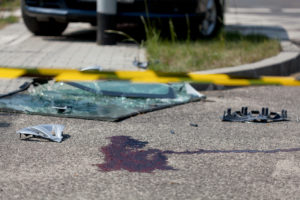Blood Loss (hemorrhage) accounts for 31% of deaths in victims of a trauma.
In the case of a catastrophic accident, or just a household incident, it’s important to know what to do if someone is injured and losing blood. An adult body contains approximately 10-12 pints of blood. Most Importantly, Blood loss of less than 1 pint of blood (the amount you would donate to a blood bank) will generally have no harmful effects. If blood loss is two pints, a person may enter a state of shock. A blood loss of 5-6 pints, which is half of the blood in an adult body, usually results in death. Controlling blood loss is essential to the survival of a person who has a severe wound.
In case of severe bleeding, follow these guidelines to administer effective aid and possibly save a life:
- Make sure the scene is safe for you and the victim.
- Call for help, or ask a bystander to call for help. Ask a bystander to call 911, get a first aid kit and AED.
- Help the injured person lie down. If a towel or blanket is available for them to lie on, it will help them retain their body heat.
Remove dirt or debris from the wound.
- If an object is embedded or large, don’t remove it. Do not probe or attempt to clean the wound, the first step is to stop the bleeding.
- Place a sterile bandage or clean cloth on the wound. Apply pressure firmly on the bandage with the palm of your hand. Maintain pressure by binding the bandage tightly with a clean piece of cloth or bandage, and secure the binding with tape if available. If you don’t have anything to bind the bandage, use your hands to maintain pressure on the bandage.
- Do not put direct pressure on an eye injury, or on an object that is embedded in the victim’s skin.
- If there are organs that are displaced, do not reposition them. Cover the wound with a clean bandage.
- Raise the injured body part above the level of the heart if possible to help slow the bleeding.
Do not remove the gauze or bandage.
- As an example, when a victim is bleeding through their bandage, apply another bandage on top of it and continue applying pressure.
- A tourniquet is an effective way to control life threatening bleeding on a limb. Only apply a tourniquet if you are trained to do so, and if you suspect the bleeding is severe enough to threaten the victim’s life. If you suspect the wound has caused arterial bleeding, a tourniquet may be essential. Bleeding from an artery is more dangerous and severe than bleeding from a vein. Arterial bleeding can be identified if the blood pumps from the wound in the rhythm of the heartbeat. Make sure you write down the time you put on the tourniquet so you can let emergency personnel know how long the tourniquet has been in place when they arrive.
- Once you have stopped the bleeding, immobilize the injured body part. Leave the bandages in place until emergency personnel arrive.
If the bleeding is caused from a major trauma or injury
it’s important to keep an eye out for signs of internal bleeding. If you notice any signs, alert emergency personnel. These signs include:
- Tender or swollen stomach
- Bruising
- Fractured bones
- Signs of shock
- Thirst
- Pale cold, clammy skin
- Shallow breathing
- Bleeding from an opening in the body (ear, mouth, nose)
- Vomiting or coughing up blood
In addition, knowing how to administer effective first aid is also a way to proactively help your community be prepared. Every two seconds in the United States, someone needs blood. Around 36,000 units of blood are needed daily. Although an estimated 38% of the population of the United States is eligible to donate blood, less than 10% actually donate each year. Blood cannot be manufactured, it can only come from donors. The blood used during an emergency is already waiting on a shelf before the event occurs.
Donating blood
is a great way to make sure our hospitals have the blood they need on hand in case of emergency. Donated blood is also used for transfusions to patients who are suffering from cancer, sickle cell disease, or any number of other illnesses. The type of blood most often requested by hospitals is type O. People that have Type O negative blood are universal donors. Type O can be transfused to patients of all blood types. Type AB positive plasma can also be transfused to all patients and is usually in short supply.
It’s easy to be a blood donor. It takes about an hour of your time to potentially save the life of a person who needs a blood transfusion. Find a local blood bank or set up a workplace blood drive and donate today!
In the Seattle area, we recommend Bloodworks Northwest for blood donation. You can find a local blood, set up a blood drive at your workplace or schedule an appointment here.


